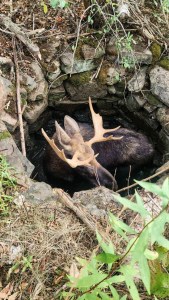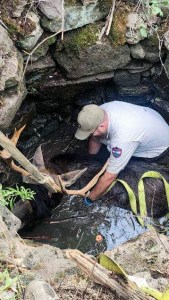Steve Dunham has spent plenty of time around Maine wildlife, but his up-close encounter with a young bull moose stuck inside an abandoned well was certainly a new experience.

Dunham, a regional wildlife biologist with the Maine Department of Inland Fisheries and Wildlife, was in his Jonesboro office on Wednesday when a call came in about a moose found in a well surrounded by trees and brush in Pembroke, a small town in Washington County.
“It’s hard to picture what that would be like,” he said.
He grabbed supplies to immobilize the large animal and headed out.
The moose had been discovered that afternoon by an employee at a custom shed business who had thrown a block of wood toward the tree line in frustration, Dunham said. The moose was startled and made a loud noise from its spot inside the well.
Dunham said no one knew the stone-lined well was even there in the middle of a thick stand of young alder and poplar trees. There was about 3 feet of water in the well, which is about 8 feet deep and 6 feet wide.
“You’re looking down and can just see its body and head as it’s moving around inside the well,” Dunham said of his first glimpse of the moose. “It could pick its head up and see out, but it couldn’t get its legs in place to find purchase to get out.”

Dunham knew getting in the well with the moose could be dangerous — “I do value my life,” he said — so he used a syringe attached to the end of a 6-foot aluminum pole to administer a sedative to the animal.
Once the moose became sleepy and laid down in the water, Dunham was able to climb down into the well. With the help of Game Warden Nathan Burke, he attached a strap to the antlers to hold the moose’s head up.
They then maneuvered two thick straps under the moose and attached them to an excavator to haul the animal out of the hole.
Once it was back on firm ground, Dunham and Burke could see that the moose did not have any visible injuries.
Dunham gave the animal a treatment to reverse the affects of the sedative. After about 20 minutes, the moose ran off into the woods.

“I think he has the best shot he can of survival,” Dunham said.
While Dunham can’t say for sure how long the moose was in the well, he believes it likely fell in earlier that day.
“He didn’t look happy in the hole, but he wasn’t completely exhausted or have any signs of being in real distress,” he said. “If he had been there longer, he would have looked worse.”
Dunham said moose hunters in the Pembroke area should avoid shooting the untagged young moose because the chemicals from the sedative make its meat unsafe for about a month.
He gave photos of the moose’s antlers to check stations in the area and asked people to call if it appears that moose is harvested this season.
The first portion of Maine’s moose-hunting season opened Monday and runs through Friday; only bulls may be hunted this week, and only by those who received a permit via the annual lottery. The second bull hunting season is in mid-October, while antlerless hunting season is held between mid-October and early November.

We invite you to add your comments. We encourage a thoughtful exchange of ideas and information on this website. By joining the conversation, you are agreeing to our commenting policy and terms of use. More information is found on our FAQs. You can modify your screen name here.
Comments are managed by our staff during regular business hours Monday through Friday as well as limited hours on Saturday and Sunday. Comments held for moderation outside of those hours may take longer to approve.
Join the Conversation
Please sign into your CentralMaine.com account to participate in conversations below. If you do not have an account, you can register or subscribe. Questions? Please see our FAQs.